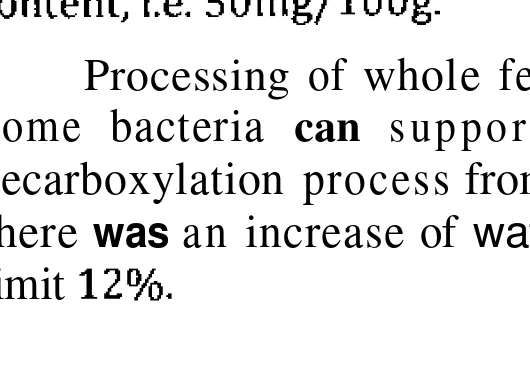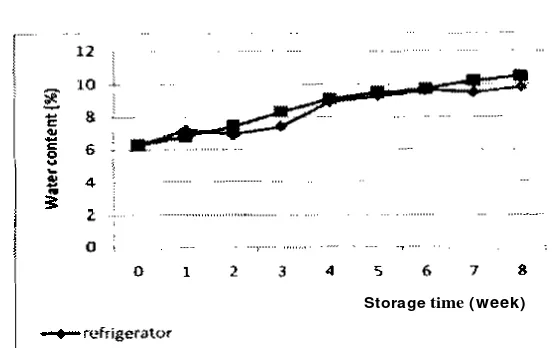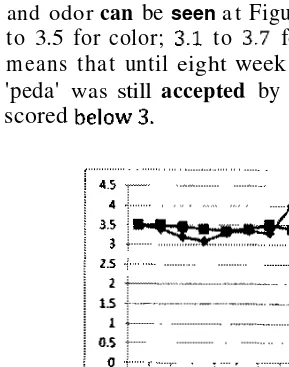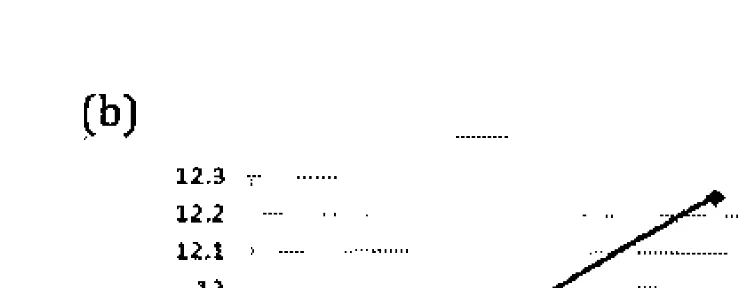consumer specifics tion, ergens, coosvnler complai~lt
Kraft 1
--
i c a I p r e s e n t a l i o n
Procr cding oj Internnrionill Seminar Curr r nt IJJ urs and C i ~ a l / p n ~ c , s in ~ o o d ,yajpn,
SHELF-LIFE PREDICTION
OF
SEASONING
POWDER
MADE
FROM WHOLE FERMENTED FISH
(PEDA)
BY
USING ARRHENIUS METHOD
Meta Mahendradattal, Februadi Bastianl, Kasmiati2, Nur Amaliah3
1 Food Science and Technology Study Program, D e p a r t m e n t of
Agricultural Technology, Faculty of Agriculture, H a s a n u d d i n University, Makassar 90245
Faculty of Marine Science and Fisheries, Hasanuddin University, Makassar 90245
3 Graduates of Food Science and Technology Study Program, Hasanuddin University
ABSTRACT
Ready to use seasoning powders in markets are commonly based on meat
extract or spices. Such seasoning powder made from fish or fish products is
rarely found, whereas the raw material has great potential. This research aimed to produce seasonirlg powder as flavor enhancer for foods which was made from whole fermented fish ('peda']. The product was stored for 8
weeks a t two different temperatures, i.e, chilling (711Cj and room temperature (280C) with aluminum foil packaging. T h e change of product
profile was evaluated and the shelf-life of product was predicted. 'Pedal was
processed by addition of clove and c i n n a m o ~ ~ . After fermentation, 'peda'
was then milled into paste. After that onion and garlic were added to t h e paste a n d the mixture was then dried. Measuring parameters used for seasoning powder were histarnine content, water content, total mesophillic n~icrobe and sensory evaluation using hedonic scale for color, texture and odor. Shelf-life prediction was carried out using Arrhenius method. Research result showed t h a t there was an increase o f histamine content
during eight weeks storage. The lowest and highest level of histamine was
found during storage at chilling temperature, i.e. 1.3 1 1 (control) and 20.144
mg/100g 1 7 t h week) respectively, whereas a t room temperature there were
5.459 (1s' week) and 19.845 mg/100g ( 7 ' h weeks), respectively. However,
the increase was still below the un-safety level. Water content and total
mesophillic microbe also increased during storage. Water content ranged
between 6.3% to 9.8% (at chilling temperature) and 6.3%) to 10.5% (at
room temperature). Total mesophillic nlicrobe rariged between 2 . 1 ~ 1 0 3 cfu
Science-Based Approach jbr Fuod Sajey Manag~gmenr f ' r r l c cc~i/jng r,l'lnlr<rnutional Scminur I.F.YUPS nnd C * f i o l l ~ ~ t i ~ r ~ ~ rtl F(J
to 8 . 7 ~ 1 0 5 cfu (chilIing temperature) and 2.86~103 cfu to 1 . S x l O b cfu (room tetnperature]. Arrhenius method was used to predict the shelf-life o f
seasoning powder because temperature is the main factor which itlfluenced
the quality of foodstuff. Shelf-life prediction based on histamine content, water content and total nlesophillic microbe at 224 days (32 weeks), 70
days (10 weeks) and 91 days (13 weeks) respectively. During storage,
response of panelists on color, texture and odor of product was evaluated. The result showed that seasoning powder made from 'peda' was still
acceptable during 8 weeks storage.
Key Words: 'peda', seasoning powder, herbs and spices, shelf-lfe.
INTRODUCTION
Ready to use seasoning powders in markets are cornmor~ly based on meat extract or spices. Such seasoning powder rr~ade from fish or fish products is rarely found, whereas the raw material h a s great potential, for example, fermented fish product that can be
developed as seasoning powder for various menus. Besides that, fish products based on fermented fish are well known and processed through local and indigenous technology like peda or fermented whole fish. The problem, which occurs oft by such process, is the formation of histamine which can cause allergy and even poisoning.
Histamine poisoning case with symptoms such as itching
in
face and neck, headache, vomiting, nausea, diarrhea, usually rapidly occurred. Avoidir~g against poisoning is necessary by inhibition the histarnine formation during processing of fishery products. Once histamine I S formed, it is difficult to destroy it. Therefore, the mostimportant thing is to avoid the decarboxylation process by inhibition
of enzyme histidine decarboxylase (HDC)-activity. I IDC takes important role to change free histidine into histamine (1H-imidazol- 4-ethanamin) through decal-boxylation.
O n e of many ways to avoid the formation of histamine is the application of materials which posses antimicrobial properties. Previous research proved that the use of clove a n d cinnamon could inhibit the activity of HDC, so automatically the Formation of histamine could be inhibited (Mahendaradatta and Adiansyah, 2007; 2008). Besides that, spices and herbs are used also in m e n u food products as flavor enhancer.
2 2 2 l t e c h n i c a l p r e s e n t a t i o n
cinnamon
s;
mi
(Rastrelliger neglectus),
in were
NaOH, N ,
IIC1,
che~nicals
Quality
is1
1998), (F
19891, 1980) sa
of
10 (5-excell
accepta
8. of
pt-edicted Arr; Halid, 19893
AnaIysis
rpm 1 ml
more anc
-
f
sunernatantwed Safe@ Management
I5 2 . 8 6 ~ 1 0 3 cfu .5x106 shelf-life
2
(13 D u r - ~ n g
It e
's: shev-/fee.
idy c o m m o ~ ~ l y
I
~tential,
bd Besidcs
processed
ferrnetlted
;h. n
the
e
11
me (HDC)-activity.
~t (IH-imidazol-
? In
HDC, 2
Pror.c~r'rf111g r!f l t l ~ ~ ' r r ~ r / ~ t c ) n d Seminar Currenf /.F.FUL'.V and Chal1en~e.v tn Food . C ~ f i w
1
By using clove and cinnamon to inhibit the HDC activity, 'peda' can be further process in seasoning powder which is safe for consumption and provide special odor for various menus.
METHODOLOGY
Materials and chemicals
Materials used in this research
were
short-bodied mackerel(Rastrelliger neglectus), table salt, cloves, cinnamon, garlic and onion.
All materials used were bought from fish market and traditional !
market in Makassar. Chemicals used in this research were histamine I dihydrochloride, trichloro acetic acid, n-butanol, N a O H , NaCl, n-
heptane, IICI, 4-nitrobenzen diazonium tetrafluoroborat. These
chemicals were bought from chemicals distributors in Makassar.
Methods
A. Product Quality
Seasoning fish-paste powder was evaluated for its histamine content (Mahendradatta and Schwedt, 19981, total bacterial (Fardiaz, 19891, water con tent (Horwitz, 1980) during eight weeks storage. The sensory properties of products (color, texture and odor) were evaluated by a 10 panelists using a five-point scale (5-excellent, 4-
good, 3-acceptable, 2-doubtful, 1-unacceptable) (Larmond, 19701. Samples graded above point 3 were considered to be acceptable for
consumption.
B. Prediction of shelf life
Shelf life of seasoning powdel- was predicted using AI-rhenius
method (Syarief and Halid, 1989)
Analysis Procedure
A. Histamine content
Ten g of each sample was homogenized with 25 1111 of 5% trichloro acetic acid (TCA) then centrifuged by 4000 rpnl for 10 minutes. The supernatant was decanted in 50 rnl measured flask. Residue was homogenized once more with 5% of TCA and then centrifuged. The supernatant was combined and filled with 5% of
Scrence- Raved Approac-h for Food Safery Manugsmcnt
1
Pror.ueding c{ Inrernur~onul Serninnr Currmt Isrurs nnd i'hirllet~grsTCA till mark and filtered. O n e ml filtrate was transferred to
I
Accentrifuge tube containing 5
ml
n-butanol, 0.25 ml NaOH 5mol/l and initia1 0.75 g NaCI. The tube was shaken for 3 minutes and centrifuged for K10 minutes at 4000 rpm. All organic phase was transferred to the second tube containing 2.5 rnl NaOH 0.1 mol/l saturated-NaC1. After
shaken and centrifuged a t the same way described previously, 4 ml organic-phase are transferred to the third tube containing 2.5 ml HCI
0.1 moI/l and 7.5 ml n-heptane. The solution
was
shaken a n d centrifuged. Acidic-phase was ready for analysis. One m: 0.2?/0 4- nitrobenzene diazonium tetrafl uorborat was added to 1 mI of acidic- phase a n d l m l 10% of Na2C03.HzO solution will be added. After 5minutes the absorbance was measured on 470 nm. B. Arrhenius Method [Syorief and Haiid, 1989)
Seasoning powder was divided into 2 parts and was stored under different temperature, i.e. 7 o C and 280C with room and refrigerator humidity 85.6% and 7 6 % respectively. Observation on the change of product characteristic was conducted every week frorn the day hcfore storage (control) until eighth week. Product quality
measured can be seen in point A. Measurement result during storage was t h e n tabulated, regressed and two regression equations has been drawn for two different conditions. From that Arrhenius equation, parameter score has been provided, i.e.
1/T
(OK) a n d In K. Furthermore,1/T
was plotted toward In K and Arrhenius equation a s well as the change of product characteristic every week was drawn.-
...
Arrhenius equation K = K u e E R T 1)
Note:
K O = constant pre exponential or absolute rate (undependable
on temperature)
Ea = activation energy of change reaction of quality
characteristic (ual/mo!j
R = cnnstant of ideal gas (1.986 cal/moll)K) T = absolute temperature (oC + 273)
Prediction of shelf-life of seasoning powder was carried out by using
semi
empirical approach with orderzero
reaction. Determination of reaction order was based on constant correlarion score of equation. The shelf-life prediction was measured using formula:T
= [A,-
A,]/ KNote:
2 2 4 1 t e c h n i c a l p r e s e n t a t i o n
measured 1 histamine
prepal
At~alysis Other
histam
conrent
C
fish fc
histii 1) agrcr
i
i (Fig.2)
I
I
rtaragc ( w t t k l1. stal
rrsed Approuch for Safev
rnl
ge n-butanol, NaOiJ 5mol/l
lac].
rtes
:ube NaOH 0.1 mol/l saturated-NaCI.
and ml
/ I
ged. 0.20/0 4-
lzene diazoniurn acidic-
10% NazC03.HzO
rrleasured 471) n m .
rhenius (Syariefand Halid,
~soning
lifferent i.e. 70C and 280C
itor hurnidity 76% Observation
Ige every
bd
I
equatiot~, i.e.
1/T
(OK)nore,
1/T
Inne
IS K c e-ERT
...
11
IJ
2rature)
q u a l ~ t y ristic (cal/mol)
11.986 cal/mol°K) (oC
In
-life
= [ A r - A,)/ K
~ n i c a l
Proci~sding oj inlet-n;nional Seminar Currrnr Isst~~ls and C'ha//enpe~,
m
Fad Sujef?-A, = standard quality of product characteristic
A, = product characteristic at initial condition K = rate of the change of product quality
Data Processing
For histamine content, the absorbance measured was plotted into standard curve. The histamine content is calculated by rn ultiplying the value with correction factor from sample preparation step, sample clean up step and standard solution (Mahendradatta, 1997).
AnaIysis was carried o u t in triplicate. Other data were processed as quantitatively descriptive.
RESULT
AND
DISCUSSIONProduct Quality
Result showed that there was a n increase of histamine content, water content and total
bacteria
for 8weeks
storage. Compared t ofish with white flesh, the higher level of histamine is found in fish
with dark flesh. It is related to the high level of free histidine in dark flesh. The increase of histamine content (Fig. 1) agreed with the increase of total bacteria (Fig.2) during storage.
I
I
O X I 3 4 5 6 7 1 1 1I stwage tlme (week) :
+rclrigcrator -rmrn
I
...Figure 1. Histamine content during 8 weeks storage
[image:5.851.94.351.387.562.2]Science-Based Appruuc-hjur k ' t ~ o ~ i Sfifew Management
Based
on
histamine content analysis, it showed that histamine content a t 8th week under room temperature and chilling temperature was 16.0877rng/lOOg and 19.168 mg/100g,res~ectivelv. The increase was still under safety limit of histamine
Processing of whole fermented fish powder involved bacteria. Some bacteria can s u p p o r t the formation of histamirie through decarboxylation process from free histidine into histamine. Although there was an increase of water content, but it did not exceed critical limit
0 1 2 3 4 5 6 7 8
storagetime {week]
[image:6.845.85.350.217.408.2];
+
f e f f l ~ c l ~ t o r j +mornFigure 2. Total bacteria during 8 weeks storage
Raw material used to produce seasoning powder was 'peda' or whole fermented fish. 'Peda' was made by fermentation process which involved some bacteria. Bacteria which are important in histamine formation included Morganella rnorganii, Klebsiella
pneumoniae and some Alvei. These bacteria could grow well in fermented fish and could produce histamine (Ward a n d Cameron, 1991).
Total mesophillic bacteria have been determined in this research, however, the optimum temperature for growth is 370C and
acco enzy
rdi ng
'me
a~ i y o t o [ I obe have
9 9 3 ) the
, the optimum great activity
temperatu
is 30 - 7(
.here Beutl
the .ing
2 2 6 I t e c h n i c a l p r e s e n t a t i o n
550C. during
5Omg/lOOg.
1998).
abIe bat
1%.
best
stor
rszd SajUty A4anagement
ied
ture 16.0877mg/lOOg mg/100g,
iely.
i.e. 50mg/100g.
lcessing acteria
cyla tion histarninc. A1
IS
6.
-
-
140
$ loo 80
-
ti
::
9 0
j 0 1 2 3 4 5 G Y S
time
+
rcfr~gerdtor+room
storagc
I
'Peda'
! forma tion Morganello morganii, Klebsiella
'ae
1
370C
(1993),
is 70°C. Beutling
-
I
Proceeding r,fInfrrtt~rliunu~ Seminar C~~rrcnr Issues and Challunge.5 II? Food ,Vufc~-
(19961 said that the maximum activity
of
HDC enzyme is a ttemperature 550C. Although there is an increase of histamine content during storage, its level
is
still below the safety limit, less than 50mg/lOOg.The addition o l
spices
into seasoning powder gave effect on inhibiting the histamine formation. I t was due to t h e bioactive compound of sy ices which have antimicrobial activity (IIirasa and Takemasa, 1998). According to Wendakoon and Sakaguchi (19951, clove and cintlamon were able to inhibit t h e growth of bacteria a n d formation of amine compound at level 1%. Mahendradatta (2005) reported that spices combination of clove and cinnamon t h a t was applied to cook fish had the best sensory score of panelist comparcd to other combinations consist of ginger and tamarind.Essential oil of spices possessed antibacterial properties. Making of seasoning powder from 'peda'
was
carried out by addingonion and garlic which have function as flavour and antimicrobial agents.
Storage time (week)
--CI rt?frigerator
+room
[image:7.851.90.368.321.495.2]I_- .- ... ... """ - - -. /
Figure 3. Change of water content during 8 weeks storage
Water content increased during eight weeks storage (Fig. 3). The increase was due t o the hygroscopic properties of product. For hygroscopic product, temperature and humidity are very important factors [Syarief et al., 1989). The increase of humidity will be
Science- Based Approach for Food Safep Management
followed by the increase of water content and it will affect the quality of product.
Sensory evaluation of seasoning powder based on color, texture and odor can be seen a t Figure 4. Sensory score ranged between 3.1 to 3.5 for color; 3.1 to 3.7 for texture; and 2.75 to 3.5 for odor. It means that until eight week storage, seasoning powder made from 'peda' was still accepted by the panels, except the odor, because it scored
2.5 .;. ... ) ( 2s
I..
...m
of lnrernationa~ Currenr ChaIIengcss mtime {we&) rtorwtimt (mtk)
stwage t h e {week)
[image:8.847.91.380.196.563.2][a) color (b) texture [ c ) odor
Figure 4. Change of sensory acceptance during 8 weeks storage
decrl t t
I
the
I t hanr
M In k
ras
O 1
;
- . .
In ti = tl/~) i
... cur!
0 s ' i
2
-
6
c :
\
= -8.t0 KI
0 00357 0.#033?
K2 :
slope
OK plol
temperatl
li
-8,8' ( l / T l *
i ~ d Foo J Sufety
:t.
b c t w e e ~ 3.1
-
2.75IS
,low
storage t h e (week)
3(Cri*frlperator *rwnl
~ o l o r [b)
4. 8 storage
I
Pruoeecl~tlg oj'/nternatronal Seminar Current Issues and Chailengrs in Food.Ttr/E~-Preference level of panels towards color decreased a t room temperature then increased a t sixth week and the decreased again until the end of storage time. Whereas at chilling temperature, preference level of panels decreased and then increase at seventh and
eight week. The preference score ranged between good until
acceptable. Seasoning powder colored brown and possessed special odor from spices added.
Prediction of Shelf Life
The food industry has a great need to obtain, in a relatively short time, the necessary information for determining the shelf-life of
its products. It has a very important impact on handling of the products' storage, distribution and shelf-life dating (Mizrahi, 2000j.
Based on measurement of histamine content, water content a n d total mesophillic microbe resulted from every observation week a t each temperatures, a n equation of linear relationship with curve slope k (constant of histamine increase) was drawn. Another linear regression of In
k
and each storage temperature(in
@K) was then drawn.... ... ...
The increase o f histamine
. . .
1 ,
-
-8.9272 r 2760 ~I/T) at each temperatur.e based
... ...
0.8 ---- on the curve o f linear
. . .
O . 6
- x relationship as follows,
- C:
- -
O.L j Chilling temperature (711C)
y = -8.889.10-6 +
0.2 j 2.525005~
o i (r= 0.8548; K l = 2.525005)
o 0 0 3 5 7 a 00332
Room temperature (281)C)
it f
lfr . [r= 0.712; Kz = 1.266188)
0
G 1 O.OL135: D M 3 3 2 Curve slope from each
- / I .. - I temperature (ln 0 was
...
1
.o.l 1 ...I
related with storagd (1/T]. . . #n k = 1,41556 . 608 (AP) ... : in OK and plotted into curve
... ... , , , , , , , , , 1 of temperature and In K -0.6 i
,0.7 i , ,
/
, , , , , , , , . . and formed linear equation.O.A .- ... In K = -8,89272 + 2760
( l / T ) .
1 . . . ... , , , , , , , , , , . .
The cut of curve a t y-
Science- Based Approach for Food Sufi@ hlutr agement Prrtreeeding lnrernatronul (lurrtwr Challenge.\
[image:10.842.37.406.57.201.2]Eb) ... ... coordinates (8.9272) was
...
12.3 _. ...
:
In KO from Arrhenius, equation. So KO was
12.1 > . . .
' 1.3273~10.~ and Arrhenius
... ...
9 2 .
i x
i 11.9 . equation for the rate of
,
-
...
~ r a . histamine increase was
11.7 . .. ,, In k=,18,65296 -,1.928i%~Tk, K = 1.3273.10-4 x e 2 7 6 0 ( l I T I
Figure 5. Linear equation
on
the changes of (a] histamine content,(b) water content and
( c )
total mesophillic microbeFrom this equation, the rate of histamine increase was calculated as follows: chilling temperature: 2.5244 mg/100g sample
weekly
and
room temperature: 1.2662 mg/100g sample weekly. Byusing
Arrhenius equation order zero, the prediction of product shelf- life could be determine through equationT
= (A,-Ao)/K, so that shelf-life of seasoning powder made from 'peda' was 32 weeks or 224 days a t room temperature and 19 weeks or 133 days at chilling temperature.
The same calculation was applied to the measurement result of water content and total mesophillic microbial. The increase of water content at each temperature based on the curve of linear
relationship was as follows,
Chilling temperature
(70C):
y = 6.4422 + 0 . 4 7 ~ (r = 0.9007;K1=
0.47) Room temperature (280C): y = 6.4578 + 0 . 5 4 6 7 ~ (r = 0.9702; K2 =0.5467)
Curve
slope
fromeach
temperature(ln
Kj
was related with storage[l/T)
inO K
and plotted into curve of temperature and In K andformed linear equation linear
In K = 1.41556 - 608(1/T) [Figure Sb). The cut of curve a t y- coordinates (1.41556) was In
KO
from Arrhenius equation. SoKO
was 4.119 and Arrhenius equationfor
the rateof
histamine increase wasK=
4.119 x e-6O*(l/T). From this equation, the rate of histamine increase was calculated as follows: chilling temperature : 0.470% sample weekly and room temperature : 0.547% sample weekly.2 3 0 I t e c h n i c a l p r e s e n t a t i o n
p~
prclduct '
' Q E
01
temperature.
ChilIing (70CJ: = +
KI = 129365.33)
( 2 8 u C ) : 209482.67~
Kz = 209482.671
K )
( 1 / T ) O K
18.65296 1928(1/T) Sc]. C18.65296) KO
126147195.3 0 1
e-1928111T). et
follok
colony/ml 209399.67 colony/ml
PI ' 'pt weeks calculati~ room




